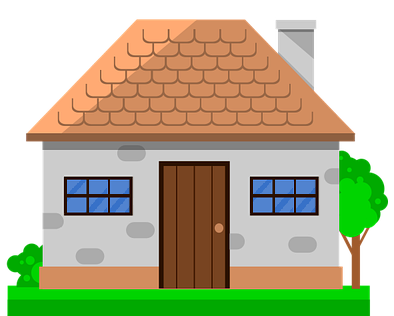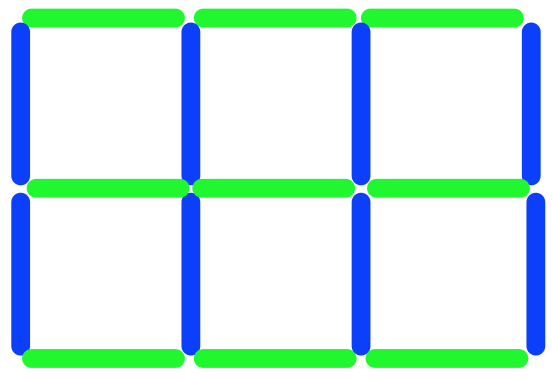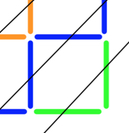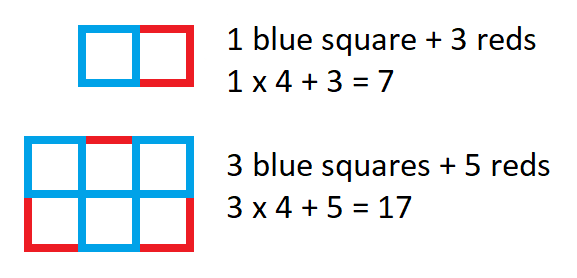Or search by topic
Number and algebra
Geometry and measure
Probability and statistics
Working mathematically
Advanced mathematics
For younger learners
Window Frames



- Problem
- Submit a Solution
- Teachers' Resources
Window Frames
The windows in my house have six panes of glass. They are three panes wide and two panes high.

Here is a simplified drawing of a window in my house. Can you see how many small pieces of edging it uses?

The pieces of frame go around the edge of the panes, so we call them 'edging pieces'. They are all the same length and there are 17 of them.
The picture above shows the edging pieces - there are 9 green pieces going across and 8 blue pieces going up.
Challenge 1
Explore other rectangular windows which are one window pane wider than they are high.
How many edging pieces do you need? (We need 17 in the example above.)
How many panes of glass are there altogether? (There are 6 in the example above.)
Explore the numbers you get as you make the windows bigger.
Challenge 2
In this picture, we can see the inside edging pieces coloured blue and the ones surrounding the shape coloured green:

This gives us 7 inside blue pieces and 10 surrounding green pieces, making 17 altogether.
Have another look at the rectangular windows from Challenge 1, which are one window pane wider than they are high.
What numbers can you get for the inside and surrounding pieces?
Using the numbers you've got from exploring rectangular windows (that are one wider than they are high), what things can you find out about those numbers? Below you can see how others started exploring.
This idea from Louis uses sloping lines:

Freya used her tables knowledge:
Petros used this idea for the areas of the windows:
Kia found a different way of looking at the little squares:

Why do this problem?
This task provides an introduction to the ideas of area and perimeter, while allowing children to practise their counting skills and spot patterns in numbers. It encourages a systematic approach and provides an opportunity for pupils to explain how they know they have all the solutions. This task gives children the opportunity to pursue their curiosity, asking questions
like "I wonder what would happen if I...?"
If curiosity is something you're developing in your classroom then the videos mentioned at the bottom of this page may be useful.
Possible approach
Begin by showing pupils a model similar to the blue and green version in the second picture. Discuss what children notice. Can they talk about the 'panes' and the 'edges'? How many of each can they see? Explain how the blue and green lines are different, and make sure that all pupils understand what the words 'height' and 'width' mean.
When pupils have understood these ideas, give them time to make the window frames and count the 'edging pieces' and 'panes'.
After each challenge, bring the whole class back together to discuss what number patterns they can see. The pictures in Challenge 3 can be used as prompts to encourage children to think of different ways of exploring these patterns.
Key questions
Tell me about how you are doing this challenge.
Are you checking your answers? How?
Possible extension
Use other windows when the longer side may be more than 1 unit longer than the narrower side. Encourage children to explore patterns, keeping the length and width of the windows no bigger than 6.
Ask children to investigate the following challenge: If you have 90 edging pieces to use, what window sizes can you make if you are allowed to use the pieces to make more than one window? Can you make windows which are all different where the number of edging pieces adds up to exactly 90?
e.g.
1 by 3 = 10, 2 by 4 = 22, 4 by 6 = 58 makes 90 altogether
1 by 6 = 19, 2 by 4 = 22, 4 by 5 = 49 makes 90 altogether
Wire Cages is a 3D version of this task.
Possible support
Some pupils may need support with working out which edging pieces to count. Providing simple models for children to move around would be helpful for all pupils.
Teacher support for curiosity
This task was created to help younger pupils pursue their curiosity within maths lessons. If you'd like any support with sparking curiosity in your pupils, these videos might be helpful.
Firstly "The Rise & Fall of Curiosity", particularly the extract [23.50 - 37.15] on "adult encouragement answering and teacher behaviour."
Secondly, "The Hungry Mind: The Origins of Curiosity", particularly the extract [8.22 - 12.29] on "Children asking questions"

First can also be found at - https://www.youtube.com/watch?v=X-0NOrIU67w
Second can also be found at https://www.youtube.com/watch?v=Wh4WAdw-oq8
You may also like
Geoboards
This practical challenge invites you to investigate the different squares you can make on a square geoboard or pegboard.

